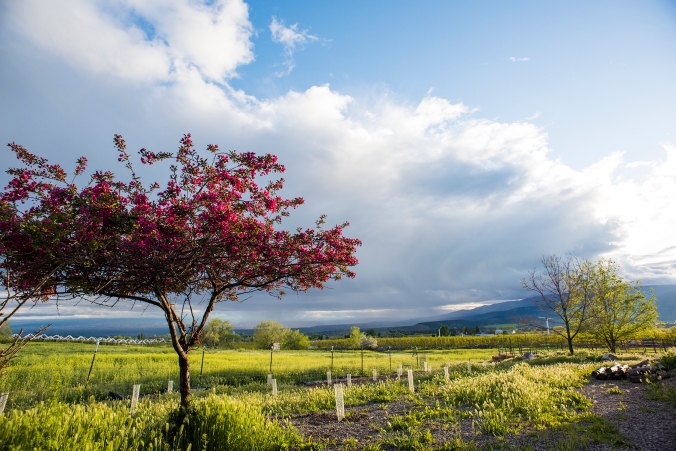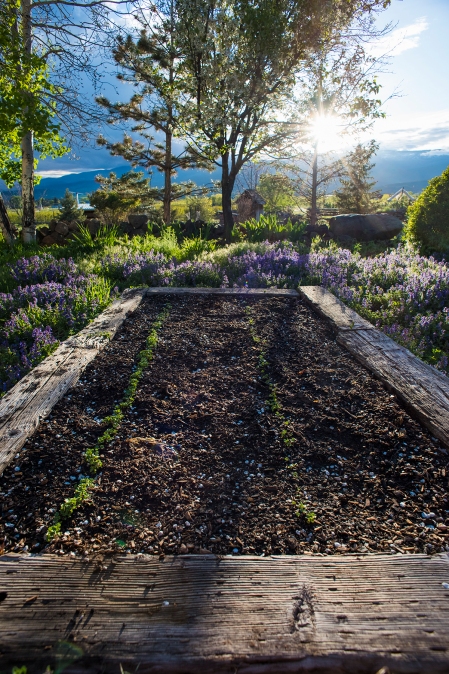Our average last frost date here at Quiet Farm is May 13; as a rough guideline, this means that it’s generally safe to plant warm-weather crops (tomatoes, peppers and so on) outside after this date. Except that we had about an inch of light, fluffy, powdery snow plus some shockingly low overnight temperatures this past week, and if we’d had all of these plants outside they would have died a chilly death. While some vegetables can handle low temperatures, our summer stars want heat and more heat, so ours are still safely tucked away in the sunroom. What do we learn from this? Always check the forecast, and never trust Colorado weather to do what you expect.

These seed potatoes are bred for the Rocky Mountain West.
We’re expecting another week of cool, wet weather, which makes it impossible to pour concrete for our fence posts. But there is always something that can be planted, even if it’s not tomatoes and peppers. Our locally-grown seed potatoes have been planted in “potato towers,” which we constructed from galvanized fencing and layers of newspapers, compost and straw. I planted a little over a pound of each variety; theoretically each pound planted should yield about ten pounds of fresh potatoes in maybe July or August. I’ve never planted potatoes in towers so am excited to see how this experiment turns out! (If you want to plant potatoes, buy certified seed potatoes and don’t plant those from the grocery store – they’ve typically been treated to prevent sprouting and therefore won’t grow.)

The beginnings of our orchard.
We’ve also been hard at work planting fruit trees. We ordered seventy-five bare-root saplings from the Colorado Forestry Service, through a terrific program that sells trees and shrubs at a very low cost to encourage landowners to plant for conservation purposes. We received twenty-five native plum (Prunus americana) and twenty-five Nanking cherry (Prunus tomentosa) trees – the Manchurian apricots (Prunus mandshurica) were lost to frost. We’ve never planted trees before and were surprised when we picked up the order – the trees were tiny, spindly little branches! But they all went into the ground, loosely secured to bamboo stakes and protected by plastic netted cages, and as far as we can tell, they’ve all started to bud out. We’re looking forward to harvesting our own fruit, if the birds and the deer don’t get to it first.

A white-lined sphinx moth (Hyles lineata) and a bee in our catmint.
Although our beehive currently sits empty (but protected by a high-voltage fence), we are thrilled to see and hear thousands of bees all over our farm. The neighboring peach and apple orchards have brought in temporary hives for pollinating, so there has been a great deal of bee activity lately. The bees seem to particularly love our blooming catmint, which is a gorgeous bright purple right now. Like other members of the mint family, catmint survives in our harsh climate without supplemental water or care and the deer ignore it, so it’s a perfect addition to our landscape.

Arugula, mustard and assorted lettuces are planted here.
That catmint above surrounds this experimental raised bed, which has been planted in partial shade with delicious spring greens and deliberately left without any sort of protection from deer or rodents. We’re testing an organic deterrent which is basically rehydrated cow and pig blood – we combine the blood powder with water, then sprinkle it over and around the crops. It’s entirely chemical-free and safe for both animals and people; the idea is that prey animals will avoid the area because they think another prey animal has met an untimely end there. Thus far we’ve definitely had both small and large creatures walk through the bed, but the crops haven’t been nibbled on. It will be interesting to see if this works on a larger scale, especially in our new orchard.

These tulips self-seeded against our south wall. (Look! More rocks!)
It’s such fun to see all the spring flowers that have appeared, especially with the wet spring we’ve had. Tulips and irises are some of my favorites, because once planted, they’re happy to be left alone – and sometimes they pop up in surprising places. Learning our farm’s seasonal evolution is one of our greatest pleasures here.
And with that, we’re once again off to work. Have a lovely week!
I am so excited for your orchard! The farm looks like it is coming along though I know it has been so much work. You guys are doing fantastic and cannot wait to finally see it.
LikeLike
Thanks, Sara! The trees are so very tiny but hopefully they’ll thrive in their new home. We’re doing our best to rejuvenate this land.
LikeLike
The photographs in this post are incredible! The sky!! Tell N amazing job.
LikeLike
Thank you, Noell! The light on these spring evenings really has been spectacular. At the moment, spring is winning for my favorite season here.
LikeLike
We have a little more than a dusting of snow last night, 3″ of heavy spring snow. Looks like you are set on cat mint, was going to send some back with you next month. Makes room for other plants like ice plant, and sedum, just to mention two. You will have a load to take back!!
LikeLike
Heavy wet snow for us this morning too, Jim! No concreting and no building of raised beds today. We look forward to giving your lovely plants a new home on the Western Slope!
LikeLike
What are so many Nanking cherry and American plum useful for? Will the American plum be used for understock onto which other cultivars can be grafted?
LikeLike
Hi Tony! We actually want to grow as much of our own food as possible, and fruit is a big part of that. Both of these do well in our uncertain climate and can be eaten fresh or used for canning and preserving. And a local farmer friend tells us that the deer avoid the Nanking cherry – which is an added bonus, of course! We don’t have much experience growing fruit trees but look forward to learning.
LikeLiked by 1 person
That is a lot of the same two kinds of fruit for a household orchard! American plum is naturalized here. It grew from understock of formerly grafted trees, and just got away into the wild. I intend to eventually add two to the home orchard, just so I can cultivate them like common Japanese plums. However, I do not want too many plums. I would prefer prunes for drying and canning. I happened to grow some beach plums from Long Island in New York. I really want to see what they are like. I don’t expect much, but they sound interesting.
LikeLike
The Colorado Forestry Service only sells the trees in bundles of twenty-five, so we were bound to buy them in those quantities. Plus, we expect a pretty substantial loss rate to deer and birds – our orchard won’t be protected by our game fence. If we get even a small amount of fruit we’d be thrilled.
LikeLiked by 1 person
When I planted my apple understock, I planted more than I would need in a grid pattern, with the intention of grafting onto them later. American plum happens to be a common understock for the stone fruits. You could graft a few if too many survive.
LikeLike
Pingback: Farm update: June 10 | Finding Quiet Farm
Pingback: Farm update: September 30 | Finding Quiet Farm
Pingback: Farm update: October 21 | Finding Quiet Farm
Pingback: Winter on the farm | Finding Quiet Farm
Pingback: Farm update: May 11 | Finding Quiet Farm
Pingback: Where the water goes | Finding Quiet Farm